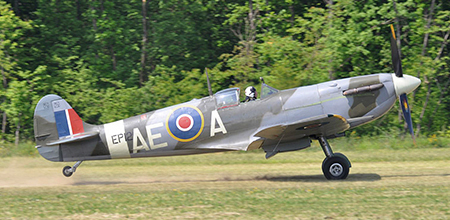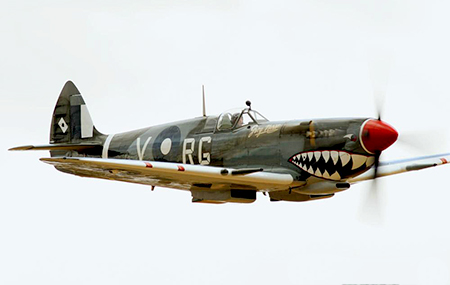Australia’s Spitfires
Australian pilots flew Mk V and Mk VIII Spitfires with Royal Air Force squadrons in Europe, the Middle East and Burma, and four Royal Australian Air Force (RAAF) squadrons – 450, 452, 453 and 457 – operated them in the former two theatres. 452 and 457 Squadrons also flew the Spitfire in the South-West Pacific Area, as did 79 and 85 Squadrons.
The first Spitfires arrived in Australia in August 1942. At first it presented some difficulties in the South-West Pacific, owing to its relatively short range and mechanical problems resulting from climatic conditions and its fragile undercarriage, which was not well-suited to the rough airstrips found throughout the Pacific Theatre. However with some modifications made to the Spitfire including ‘tropicalisation’ to improve cooling to the engine the Spitfire proved to be an outstanding aircraft for the RAAF during the latter years of World War II.
With the jet-age looming and the faster more powerful Mustang aircraft being adopted by the RAAF, the Spitfire was effectively retired at the end of the Second World War with a total of 656 Spitfires serving with the RAAF.

The MkV Spitfire
With the arrival of the Me109F, an interim aircraft was produced by Supermarine by mating the latest 1230 horsepower V-12 Merlin engine to a newly strengthened airframe. To accommodate the variety of roles and theatres of operation the Spitfire was finding itself in, three patterns of wing were introduced each equipped with a different configuration of machine guns and/or cannon. The Mk V could be fitted with:eight 0.303 Browning machine guns. two 20mm cannon, and four Browning machine guns. either four cannon or either of the other combinations.6478 of the Mk V were produced and a number the wings were adapted for high altitude, with familiar pointed tips or a low altitude model featuring clipped wingtips, for a faster roll rate. The supercharger settings on the Merlin engine could then be set for the selected altitude. Aircraft intended for desert conditions also acquired a deep “chin” air filter to keep out dust and sand.

Specifications
Manufacturer: Supermarine Division of Vickers-Armstrong Ltd.
Type: Fighter
Engine: 1, Rolls-Royce Merlin 45, 12-cylinders, V, LC, 1440 hp
Wingspan: 36ft 10in (11.23m) Length: 29ft 11in (9.12m) Height: 11ft 5in (3.48m)
Weight: 6,417 lbs, (2,910 kg)
Maximum level speed: 380 mph, (612 km/h)
Ceiling: 37,750 ft, (11,500 m)
Range: 395 miles, (636 km)
Armament: 2 x 20mm cannons; 4 machine guns
Crew: 1
The MkVIII Spitfire
The Mark VIII was essentially a modified Mk VII fitted with either a 1565 HP Merlin 61 or a 1710 HP Merlin 63 engine driving a 4-bladed propeller. The aircraft was particularly suited to lower altitudes, particularly as the cockpit was unpressurised.
Supermarine in conjunction with Rolls Royce redesigned the carburetor to enable the aircraft to perform negative “g” maneuvering. The Mk VIII was intended as the next major developmental line for the Spitfire, but with the Mk IX hurried into service, only 1652 were eventually produced, many modified for tropical climates such as those experienced by RAAF aircraft in the Pacific Theatre.
Specifications
Manufacturer: Supermarine Division of Vickers-Armstrong Ltd.
Type: Fighter
Engine: 1, Rolls-Royce Merlin 66, 12-cylinders, V, LC, 1580 hp
with a two speed, two-stage supercharger.
Wingspan: 36ft 10in (11.23m) Length: 31ft 3½in (9.54m) Height: 12ft 7¾in (3.85m)
Weight: 5,805 lbs, (2,633 kg
Maximum speed: 416 mph, (669 km/h)
Ceiling: 41,500 ft
Range: 660 miles
Armament: Two 20mm Hispano Cannons; Four .303 in. Browning Machine Guns.
Provision for one 500 lb (227 kg) or two 250 lb (114 kg) bombs.
Crew: 1

That Distinctive Sound
Nothing compares to the distinctive sound of a Rolls Royce V-12 Merlin engine. Click on the sound files below and enjoy that sound.

